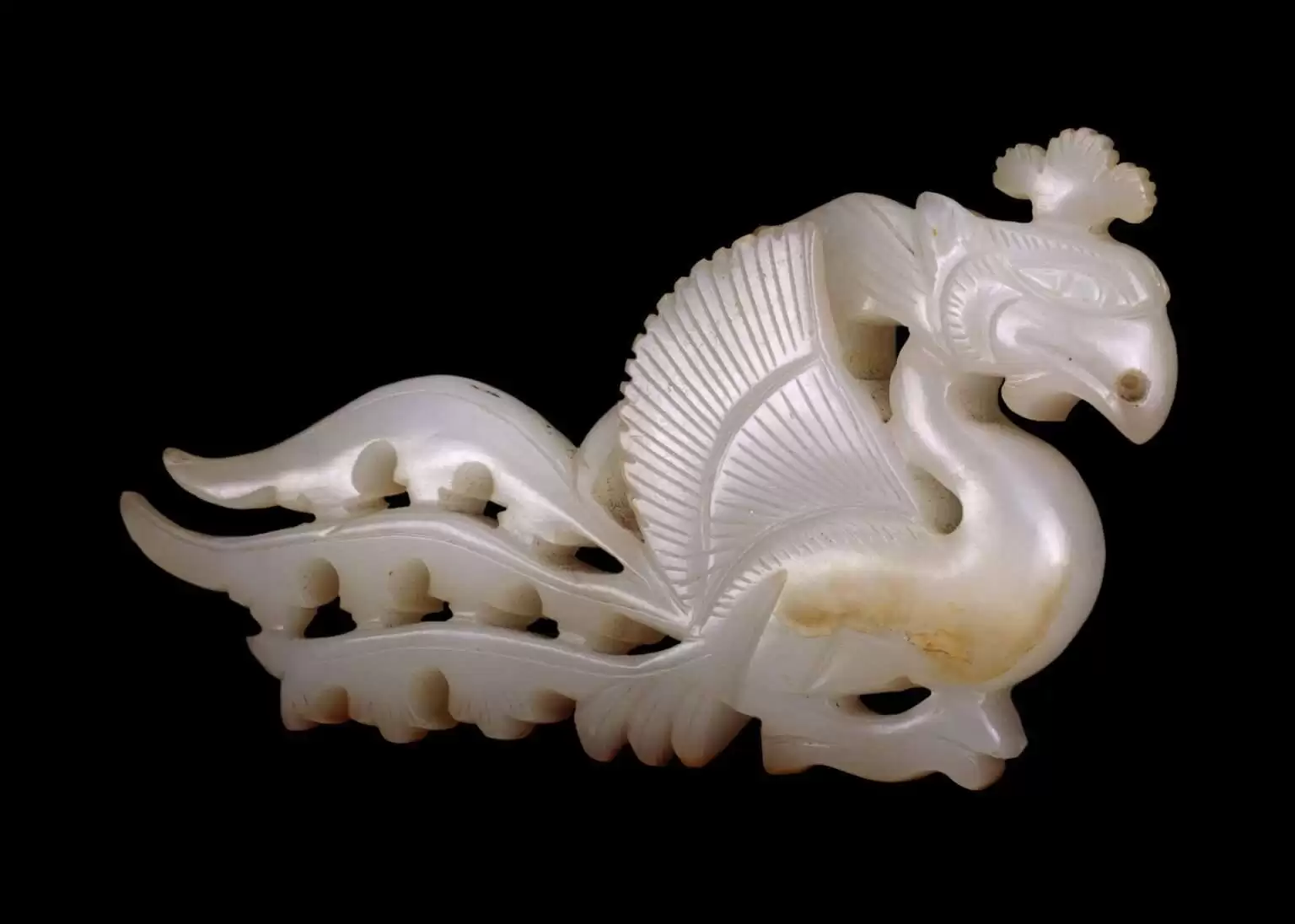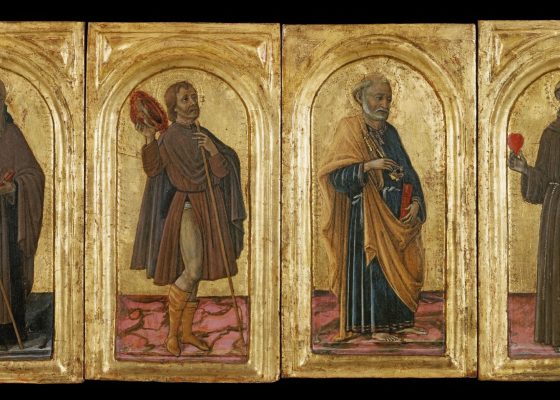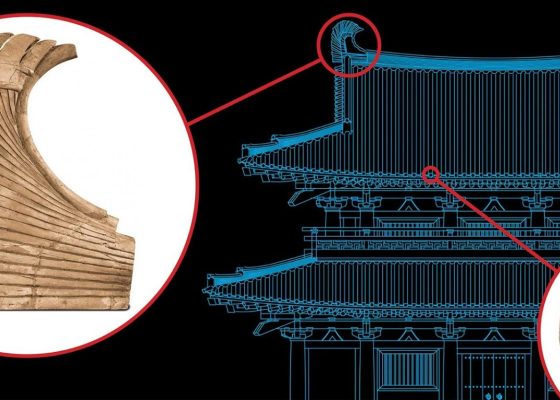
By Anthony Miller
Jade (from the mineral jadeite), has an intense green color, it is also white, the latter is appreciated in Europe. It is reputed for its durability, magical qualities and beauty. Some ancient cultures worked it and embellished their culture, such as the Mayans and the Chinese. However, in China it reached its most refined and exquisite carving. It was worked by Chinese artisans in ornaments, for ceremonial weapons and ritual objects.
We present here some objects made of or with jade, mostly from the Sir Joseph Hotung Collection of the British Museum, which was described in a previous article.




Object Typ: teapot. Description: Tea-pot. Made of Yixing stoneware, encased in pewter and with jade handle, spout and knob for cover. Inscription. Decorated on one side with branches and two birds (swallows). Cultures/periods: Qing dynast. Production date: 1768-1822. Production place Made in: Yixing. Asia: China: Jiangsu (province): Yixing. Materials: stoneware, pewter, jade. Technique: moulded. Dimensions: Height: 8.50 centimetres; Width: 14.50 centimetres (spout to handle) (spout to handle). Inscription type: maker’s mark. Inscription position: inside. Inscription language: Chinese. Inscription script: Seal script. Inscription content: 楊彭年製. Inscription transliteration: Yang Pengnian zhi. Inscription translation: Made by Yang Pengnian. (Photos: Creative Commons Attribution-NonCommercial-ShareAlike 4.0 International (CC BY-NC-SA 4.0)/ British Museum)
Object Type: cup. Description: Jade cup; carved from nephrite and polished; inscribed with the name Ulugh-Beg Kuragan, with later (Ottoman) silver repair. Periods: Timurid dynasty, Ottoman dynasty (repair). Production date: 1420-1449. Production place: made in: Samarkand (?), Asia: Central Asia: Uzbekistan: Samarkand. Technique: carved; polished; engraved. Dimensions: height: Height: 7.30 centimetres, width: Width: 19.50 centimetres. depth: Depth: 12.40 centimetres. (Photos: Creative Commons Reconocimiento-NoComercial-CompartirIgual 4.0 Internacional (CC BY-NC-SA 4.0)/ British Museum)
Object Type: Book. Description: Book on 10 leaves, engraved with two dragons and inscriptions in Chinese and Manchu recording the change of posthumous name of the Empress. Dated. Made of engraved jade, strung on flat yellow cord, with yellow silk binding and four rectangles of yellow silk woven with design in gold thread (to act as padding between the book leaves). Producer: Name Calligrapher: Qianlong Emperor 乾隆皇帝. Cultures/periods: Qianlong. Production date: 1736.
Production place: Made in: Beijing (city), Asia: China: Beijing (municipality): Beijing (city). Materials: Jade silk. Technique: engraved. Dimensions: Length: 29.20 centimetres; Width: 12.70 centimetres (each leaf). (Photos: Creative Commons Reconocimiento-NoComercial-CompartirIgual 4.0 Internacional (CC BY-NC-SA 4.0)/ British Museum).
Inscription language: Chinese; Inscription script: Chinese.
Inscription content: 維乾隆元年歲次丙辰三月乙未朔越十一日乙巳 孝孫嗣皇帝臣弘曆謹稽首再拜 上言 功同厚載襄治化于 昌朝 禮重鴻稱耀 徽音于寶冊夙合二儀之撰聿垂奕葉之光欽惟 孝誠恭肅正位安和俪天襄聖仁皇後
Inscription transliteration: Wei Qianlong Yuannian suici bingchen sanyue yiwei shuoyue shiyi ri yisi Xiaosun si huangdi chen Hong Li jin jishou zaibai Shangyan gongtong houzai xiangzhi huayu changchao Lizhong hongcheng yao huiyin yu baoce suhe eryi zhi zhuanyu chui yiye zhiguang qin wei Xiao cheng gong su zheng wei an he li tian xiang sheng ren Huanghou
Inscription translation: This is the 12th day of the 3rd month [the month of yiwei] of the year of bingchen [AD 1736], the first year of Qianlong, at the time of yisi [ca. 0930 am]. The dutiful grandson and the succeeding Emperor Hongli did obeisance with respects again and told to Empress of “Xiaocheng Gongsu Zhengwei Anhe Litian Xiangsheng Ren”, who has made great contribution to the prosperous dynasty and whose virtues will be forever remembered by offspring –
Inscription note: Page 1 Translation by Chen Yi, Oxford University, July 2010.
Inscription content: 性秉溫柔 範垂莊肅 潔蘋蘩于 九廟祭祀加虔 奉滫瀡于重闱晨昏致謹孝慈育物椒庭之令則宏昭誠敬持躬蘭殿之芳 徽允播勞心阃阈常分 宵盱之憂勤贊化宮闱克佐升平之治理溯仁風之已遠彤管方
Inscription transliteration: Xing bing wengong fan chui zhuangsu jie ping fan yu jiumiao jisi jiaqian feng xiusui yu gongwei chenhun zhijin xiaoci yuwu jiaoting zhi ling ze hongzhao chengjing chigong landian zhi fang hui yun bo laoxin kunyu changfen xiaoxu zhi youqin zanhua gongwei kezhu shengping zhi zhiling su renfeng zhi yi yuan tongguang fang
Inscription translation: “The Empress has been submissive and dignified. Her conscientiousness in offerings to ancestors, being an example in the palace and assisting the Emperor was just like the great (kindhearted) manner in the ancient time. Her manner greatly honours the womenfolk.
Inscription note: Page 2. Translation by Chen Yi, Oxford University, July 2010.
Inscription content: 輝緬 懿誨之長垂瑤函正煥欽承丕緒值典禮之維新式考彜章方顯 揚之莫罄謹奉冊寶增上尊益曰 孝誠恭肅正位安和俪淑懿天襄聖仁皇後伏冀 淑靈式庇 嘉德惟馨永贻昌熾之庥益佑和恒之福謹言
Inscription transliteration: hui mian yihui zhi changchui yaohan zhenghuan qnicheng pixu zhi dianli zhi weixin shikao yizhang fang xian yang zhi moqin jinfeng cebao zeng shangzun yue Xiaocheng gongsu zhengwei hanhe lishu yitian xiangsheng ren Huanghou fuji Shulingshipi Jiade weixin yongyi changchi zhi xiu yiyou heheng zhi fu jinyan
Inscription translation: and her teaching will be remembered. A ceremony will be given to change her posthumous title into the Emperor of ‘Xiaocheng Gongsu Zhengwei Anhe Li Shu Yi Tian Xiang Sheng Ren’, so that her greatness will be manifested. May us always have the kind and peaceful blessing from her. ”
Inscription note: Page 3 Translation by Chen Yi, Oxford University, July 2010.
Inscription type: inscription
Inscription language: Manchu
Inscription script: Manchu
Inscription note: 5 pages in Manchu script follow the 3 pages written in Chinese.
Source: British Museum








Cancel anytime


Using our website
You may use the The Middle Land website subject to the Terms and Conditions set out on this page. Visit this page regularly to check the latest Terms and Conditions. Access and use of this site constitutes your acceptance of the Terms and Conditions in-force at the time of use.
Intellectual property
Names, images and logos displayed on this site that identify The Middle Land are the intellectual property of New San Cai Inc. Copying any of this material is not permitted without prior written approval from the owner of the relevant intellectual property rights.
Requests for such approval should be directed to the competition committee.
Please provide details of your intended use of the relevant material and include your contact details including name, address, telephone number, fax number and email.
Linking policy
You do not have to ask permission to link directly to pages hosted on this website. However, we do not permit our pages to be loaded directly into frames on your website. Our pages must load into the user’s entire window.
The Middle Land is not responsible for the contents or reliability of any site to which it is hyperlinked and does not necessarily endorse the views expressed within them. Linking to or from this site should not be taken as endorsement of any kind. We cannot guarantee that these links will work all the time and have no control over the availability of the linked pages.
Submissions
All information, data, text, graphics or any other materials whatsoever uploaded or transmitted by you is your sole responsibility. This means that you are entirely responsible for all content you upload, post, email or otherwise transmit to the The Middle Land website.
Virus protection
We make every effort to check and test material at all stages of production. It is always recommended to run an anti-virus program on all material downloaded from the Internet. We cannot accept any responsibility for any loss, disruption or damage to your data or computer system, which may occur while using material derived from this website.
Disclaimer
The website is provided ‘as is’, without any representation or endorsement made, and without warranty of any kind whether express or implied.
Your use of any information or materials on this website is entirely at your own risk, for which we shall not be liable. It is your responsibility to ensure any products, services or information available through this website meet your specific requirements.
We do not warrant the operation of this site will be uninterrupted or error free, that defects will be corrected, or that this site or the server that makes it available are free of viruses or represent the full functionality, accuracy and reliability of the materials. In no event will we be liable for any loss or damage including, without limitation, loss of profits, indirect or consequential loss or damage, or any loss or damages whatsoever arising from the use, or loss of data, arising out of – or in connection with – the use of this website.
Last Updated: September 11, 2024
New San Cai Inc. (hereinafter “The Middle Land,” “we,” “us,” or “our”) owns and operates www.themiddleland.com, its affiliated websites and applications (our “Sites”), and provides related products, services, newsletters, and other offerings (together with the Sites, our “Services”) to art lovers and visitors around the world.
This Privacy Policy (the “Policy”) is intended to provide you with information on how we collect, use, and share your personal data. We process personal data from visitors of our Sites, users of our Services, readers or bloggers (collectively, “you” or “your”). Personal data is any information about you. This Policy also describes your choices regarding use, access, and correction of your personal information.
If after reading this Policy you have additional questions or would like further information, please email at middleland@protonmail.com.
PERSONAL DATA WE COLLECT AND HOW WE USE IT
We collect and process personal data only for lawful reasons, such as our legitimate business interests, your consent, or to fulfill our legal or contractual obligations.
Information You Provide to Us
Most of the information Join Talents collects is provided by you voluntarily while using our Services. We do not request highly sensitive data, such as health or medical information, racial or ethnic origin, political opinions, religious or philosophical beliefs, trade union membership, etc. and we ask that you refrain from sending us any such information.
Here are the types of personal data that you voluntarily provide to us:
As a registered users or customers, you may ask us to review or retrieve emails sent to your business. We will access these emails to provide these services for you.
We use the personal data you provide to us for the following business purposes:
Information Obtained from Third-Party Sources
We collect and publish biographical and other information about users, which we use to promote the articles and our bloggers who use our sites. If you provide personal information about others, or if others give us your information, we will only use that information for the specific reason for which it was provided.
Information We Collect by Automated Means
Log Files
The site uses your IP address to help diagnose server problems, and to administer our website. We use your IP addresses to analyze trends and gather broad demographic information for aggregate use.
Every time you access our Site, some data is temporarily stored and processed in a log file, such as your IP addresses, the browser types, the operating systems, the recalled page, or the date and time of the recall. This data is only evaluated for statistical purposes, such as to help us diagnose problems with our servers, to administer our sites, or to improve our Services.
Do Not Track
Your browser or device may include “Do Not Track” functionality. Our information collection and disclosure practices, and the choices that we provide to customers, will continue to operate as described in this Privacy Policy, whether or not a “Do Not Track” signal is received.
HOW WE SHARE YOUR INFORMATION
We may share your personal data with third parties only in the ways that are described in this Privacy Policy. We do not sell, rent, or lease your personal data to third parties, and We does not transfer your personal data to third parties for their direct marketing purposes.
We may share your personal data with third parties as follows:
There may be other instances where we share your personal data with third parties based on your consent.
HOW WE STORE AND SECURE YOUR INFORMATION
We retain your information for as long as your account is active or as needed to provide you Services. If you wish to cancel your account, please contact us middleland@protonmail.com. We will retain and use your personal data as necessary to comply with legal obligations, resolve disputes, and enforce our agreements.
All you and our data are stored in the server in the United States, we do not sales or transfer your personal data to the third party. All information you provide is stored on a secure server, and we generally accepted industry standards to protect the personal data we process both during transmission and once received.
YOUR RIGHTS/OPT OUT
You may correct, update, amend, delete/remove, or deactivate your account and personal data by making the change on your Blog on www.themiddleland.com or by emailing middleland@protonmail.com. We will respond to your request within a reasonable timeframe.
You may choose to stop receiving Join Talents newsletters or marketing emails at any time by following the unsubscribe instructions included in those communications, or you can email us at middleland@protonmail.com
LINKS TO OTHER WEBSITES
The Middle Land include links to other websites whose privacy practices may differ from that of ours. If you submit personal data to any of those sites, your information is governed by their privacy statements. We encourage you to carefully read the Privacy Policy of any website you visit.
NOTE TO PARENTS OR GUARDIANS
Our Services are not intended for use by children, and we do not knowingly or intentionally solicit data from or market to children under the age of 18. We reserve the right to delete the child’s information and the child’s registration on the Sites.
PRIVACY POLICY CHANGES
We may update this Privacy Policy to reflect changes to our personal data processing practices. If any material changes are made, we will notify you on the Sites prior to the change becoming effective. You are encouraged to periodically review this Policy.
HOW TO CONTACT US
If you have any questions about our Privacy Policy, please email middleland@protonmail.com
The Michelin brothers created the guide, which included information like maps, car mechanics listings, hotels and petrol stations across France to spur demand.
The guide began to award stars to fine dining restaurants in 1926.
At first, they offered just one star, the concept was expanded in 1931 to include one, two and three stars. One star establishments represent a “very good restaurant in its category”. Two honour “excellent cooking, worth a detour” and three reward “exceptional cuisine, worth a
Thank you for your participation,
please Log in or Sign up to Vote

123Sign in to your account